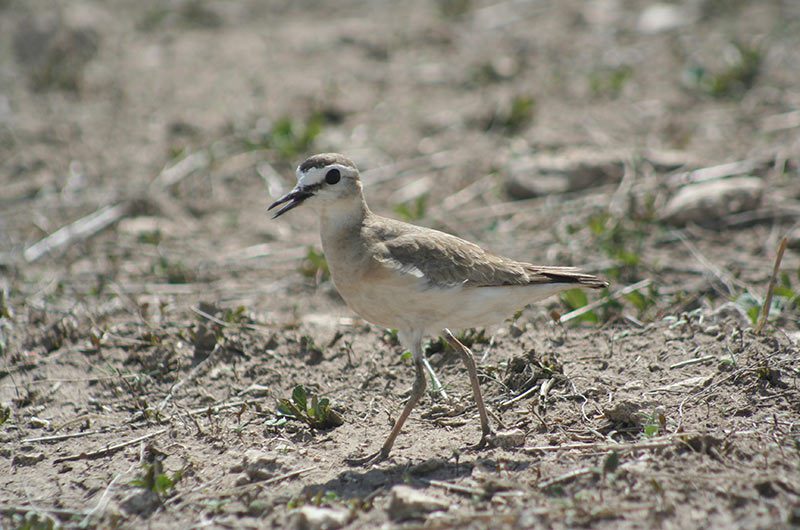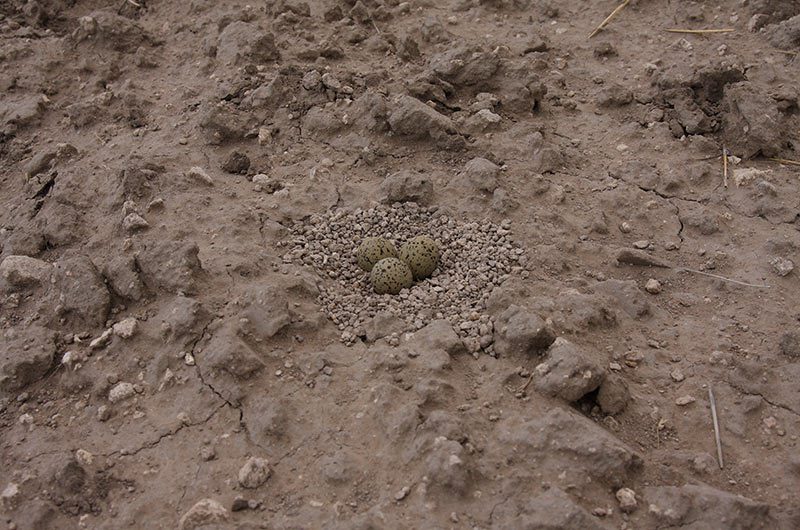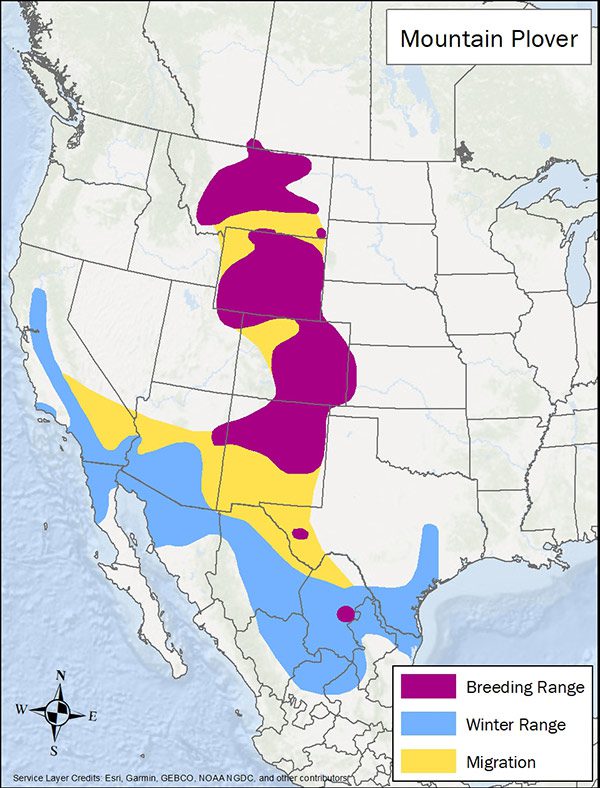LandPKS Learning
Habitat Hub

Mountain Plover
The mountain plover has an unusual mating strategy to increase hatching success of their young. The male builds two nests on the ground (see photo above), often incorporating bits of rocks or even cow pies. The female lays 3 eggs in each nest. The adults are likely not monogamous so there could be more than one father! Each adult incubates a nest to double the likelihood of success, this uniparental strategy is rare among shorebirds.
Charadrius montanus
Identification
Mountain plovers are similar in size to a robin, approximately 8 in/20 cm tall, and are often easily mistaken for a killdeer, but they are less common. In summer, mountain plovers are mostly light brown with a white throat and breast and white under the wings. It has a white forehead and white line over the eye, contrasting with a dark brown cap. Plovers blend in extremely well with the background, making them very difficult to spot, especially when they hunker down on their nests. The winter plumage is similar to the summer plumage, but the brown colors are paler.

Photo Credit: Colin Woolley/Bird Conservancy of the Rockies
Observation Tips
Mountain plover arrive to their breeding grounds in early April and can be seen on fallow crop fields, prairie dog towns, and other areas with bare ground. Their wintering grounds are similar in terms of vegetation and bare ground. Plovers lack the black bands across the chest found on their more common (and noisier) relative, the killdeer. They are affectionately known as the ”Prairie Ghost” due to their cryptic nature. In August, plovers will leave their breeding grounds and spend several weeks in migratory habitats before leaving for their wintering grounds in Texas, California, and Mexico.
Interesting Fact
The mountain plover has an unusual mating strategy to increase hatching success of their young. The male builds two nests on the ground (see photo above), often incorporating bits of rocks or even cow pies. The female lays 3 eggs in each nest. The adults are likely not monogamous so there could be more than one father! Each adult incubates a nest to double the likelihood of success, this uniparental strategy is rare among shorebirds.
Ideal Habitat
Despite the name, mountain plovers breed in shortgrass prairie where the land is fairly flat or gently sloped, <12%. They favor areas where vegetation is sparse, >30% bare ground, and very short, <3 in/7.6 cm or less. Dry alkaline lakes (playa wetlands) are attractive to plovers, as are areas that have been recently grazed by livestock or active prairie dog towns which usually have reduced vegetation height and density. Plovers will nest and forage in prairie dog towns, recently heavily grazed or burned rangeland, and fallow agricultural fields. Nests are placed on the ground.

Management Activities that Benefit Species – Best Management Practices (BMPs)
Where appropriate, manage for native shortgrass prairie of blue grama and buffalo grass. Because mountain plovers require very short grass and bare ground for nesting, pastures grazed in the late growing season and non-growing season (late summer through winter) should provide plover habitat. Grazing can be heavier in wet years and moderate in dry years to maintain habitat for plovers. Heavy grazing in the summer growing season provides less breeding habitat than heavy grazing in the winter. Burn shortgrass prairie outside of the nesting season to create favorable vegetation conditions. Retain some populations of prairie dogs at levels compatible with economic activities on the land. Annual haying in late summer can create suitable breeding habitat for the subsequent year.
Management Activities to Avoid
Avoid conversion of native shortgrass and mixed grass prairies to cropland and residential development. If prairie dog population control is needed, choose an integrated pest management approach that meets goals without eliminating the entire colony or harming other species. When possible, avoid eliminating all prairie dogs from a ranch, which may be detrimental to plovers, as prairie dogs provide the low, sparse vegetation structure favored by plovers. Burrowing owls and many other animals also depend on prairie dog habitat. Avoid use of pesticides on crops where possible.
Other Species that Benefit from Similar Habitat Management
Other wildlife that may benefit from habitat management for mountain plovers include horned larks, prairie dogs, burrowing owls, and thick-billed longspurs.
Download
Download the Mountain Plover factsheet
Other Resources
BirdLife International and Handbook of the Birds of the World. 2019. Bird species distribution maps of the world. Version 2019.1. Mountain plover.
The Cornell Lab of Ornithology. Birds of the World (Mountain plover).
The Cornell Lab of Ornithology. All About Birds (Mountain plover).
NatureServe. 2019. NatureServe Explorer: An online encyclopedia of life [web application]. Version 7.1. NatureServe, Arlington, Virginia. Mountain plover.
Dechant, J. A., M. L. Sondreal, D. H. Johnson, L. D. Igl, C. M. Goldade, P. A. Rabie, and B. R. Euliss. 1999 (revised 2002). Effects of management practices on grassland birds: Mountain plover. Northern Prairie Wildlife Research Center, Jamestown, ND. 33 pages.
Mobile App | Data Portal | Knowledge Hub | Habitat Hub | Learning Collections | Blog | About | Contact | Support



